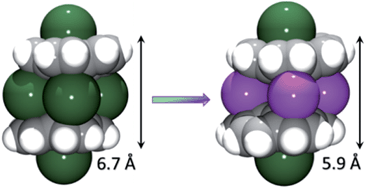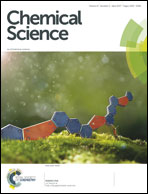Tuning the separation and coupling of corannulene trianion-radicals through sizable alkali metal belts†
Abstract
The first heterobimetallic sandwich-type aggregate formed by bowl-shaped corannulene trianion-radicals, C20H10˙3−, has been synthesized using mixed-metal reduction of C20H10. The product was crystallographically characterized to reveal the self-assembly of [Cs+//(C20H103−)/4K+/(C20H103−)//Cs+], in which two triply-charged corannulene decks encapsulate a rectangle of four potassium ions (the K⋯K separations are 4.212(4) and 5.185(4) Å), with the exterior concave bowl cavities being selectively filled by one cesium ion each. In order to provide insights into the geometrical features and electronic structure of this novel mixed-metal organometallic self-assembly, an in-depth theoretical investigation has been carried out. Specifically, the influence of internal metal binding on the geometry and magnetic coupling of C20H10˙3− radicals is investigated for Group 1 metals. This study reveals that replacement of the sandwiched potassium ions with larger (Cs) and smaller (Li) ions allows variation of the size of the encapsulated metal belts, and thus enables tuning of the coupling of C20H10˙3− radicals.



 Please wait while we load your content...
Please wait while we load your content...